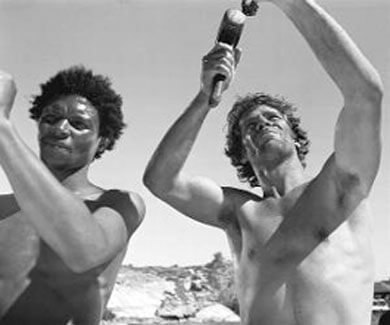MoMA showcases a film noted for its historical truth and faith in gay love
Now that it is legal for two men to make love in the United States, and while doing so nearly receive the same tax benefits as heterosexuals, it bears remembering a time when anal penetration was a perilous exercise in sexual expression that could land a fellow some hard time, courtesy of the discriminatory statutes of an imperialistic white power.
In this case, that empire was the same Netherlands where gays and lesbians now legally marry, but whose global domination in the 17th and 18th centuries imposed colonial laws on places like New Amsterdam where officials locked up men who had sex with men.
Canada’s award-winning filmmaker John Greyson, the proud gay director of “Lilies” (1996) and “Law of Enclosures” (2000) among other titles, will screen his film “Proteus” this weekend at a Canadian film showcase sponsored by the Museum of Modern Art.
“Proteus” chronicles a tale of same-sex love and the punishment faced by two convicts who, after a ten-year relationship, are tried for the crime of sodomy committed during their internment on Robben Island, the same South African gulag where a young Nelson Mandela grew old waiting for apartheid’s demise.
The time is 1730 and Claas Bank, a black bilingual herder, played by Rouxnet Brown, arrives on Robben to serve ten years. He gets the assignment of hauling water for Virgil Niven, played by Shaun Smyth, an English botanist, who is entranced by the stoic Bank. During his daily labors, Bank, who was previously not a “sodomite,” encounters Rijkhaart Jacobsz, “the faggot,” a white Dutch sailor who is serving time for sodomy.
Bank and Jacobsz begin an intimate discovery of love and sexual arousal that soon enough raises the suspicion of their jailers. (Among other things, the relationship also belies certain historians’ assertions that “gay” is a 19th century notion devoid of social qualifications, that is, outside the context of public restroom raids by working class cops bent on humiliating upper class gentlemen.)
John Greyson and Jack Lewis, two innovative gay filmmakers and promoters of independent queer cinematic ventures, collaborated to make a film that evokes the sweetness of two high school jocks with a crush on each other combined with the lust of two men systematically tortured by the sadistic laws of an imperial metropolis gobbling up the world’s natural resources.
As with most stories of two men who fall in love, make love and then stand up for it in front of other men, this story ends brutally as well.
It is a boon for queer history that South African Lewis had the vision to know what he had found when he came across those 1705 prison trail transcripts.
“Proteus” is part of an eight-film showcase being screened at the Gramercy Theater until Monday. That the presentation includes a film that so boldly tackles the issue of sodomy is due in part to Larry Kardish, the senior curator in the film division at MoMA, who played a pivotal role in selecting this year’s Canadian films. “The museum is above all an educational institution,” said Kardish. “We’re chartered as such, and the first museum to recognize filmmaking as an art form.” The museum has certainly fulfilled that mission since 1968, the year Kardish started at MoMA. “The relationship of the two men in ‘Proteus’ is as important as the polemics involved,” said Kardish, who sought to underscore that the most important criteria for all showcase films is their cinematic integrity. The Canadian movies Kardish described as “visually stunning and humane.”
Stephen Lan handles publicity for Telefilm, the organization that funds the foreign promotion of Canadian films. Among this year’s exports, “Proteus” strikes a chord. “I haven’t seen too many queer films based on black men. That coupled with its historical basis, makes this movie very noteworthy,” said Lan.
Kardish said that “at its heart, ‘Proteus’ is a gay story,” and also remarked that Greyson is an inventive filmmaker with a respected filmography. That said, Kardish wants movie lovers to check out all the Canadian movies MoMA is featuring this weekend.
As for Canada’s pioneering gay filmmakers, Kardish expressed appreciation for Telefilm, which he said “has supported gay films American filmmakers would find it impossible to put on in the United States.”


































